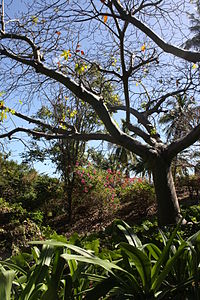Andromeda Gardens

Andromeda Botanic Gardens is a 6-acre (2.4 ha) botanical garden and an historic cultural attraction in the village of Bathsheba, Saint Joseph in Barbados. It is an authentic garden created by multiple award-winning horticulturalist Iris Bannochie, a female, Barbadian, self-taught scientist. It is unique, having been created from the 1950s as both a private botanical garden and a pleasure garden by an individual. Named from the Greek mythological figure of Andromeda it started as a private plant collection around Ms Bannochie's home, who was also the leading expert on horticulture on the island.[1] Ms Bannochie wrote various academic papers from topics including the lifecycle of the whistling frog, and the vitamin C content of the Barbadian cherry. She was a mentor to many and considered the queen of Barbadian horticulture. At one point, she was responsible for introducing over 80% of the ornamental plants found in Barbados.
Andromeda Botanic Gardens is a Partner Garden of the UK Royal Horticultural Society, the only garden with such a status in the West Indies. In October 2019, the garden received the Botanical Treasure Award from the Biological Education and Research Programme, in recognition of it biological diversity. It has appeared on UK television and was the subject of the first online lecture in September 2020, facilitated by Kew Mutual Improvement Society at the Royal Botanic Gardens, Kew.
Andromeda Botanic Gardens was first open to the public during a fund raising event hosted by the Barbados Horticultural Society in the 1970s. Andromeda was well received, and has remained open to the public by paid admission since then. Andromeda has over five hundred different species of plants adapted to a range of tropical environments. In 2018, the Palm Garden contained over 50 different species of palm and there were approximately 100 different tree species. Over 90 plant families are represented at Andromeda Botanic Gardens, making this garden one of the most plant diverse gardens in the tropical world.
Iris Bannochie founded the garden in 1954 on land owned by her family since 1740, and showed plants from Andromeda both independently and with the Barbados Horticultural Society many times at the RHS Chelsea Flower Show in London. In 1982, Ms Bannochie's display was titled Andromeda Gardens at the Show and her exhibition of palms was the largest selection of that plant family ever seen at the Chelsea Flower Show. In 1990, the garden had 40,000 visitors.[2] Andromeda Botanic Gardens is the only Royal Horticultural Society Partner Garden in the West Indies, receiving that status in 2016.
Andromeda Botanic Gardens is owned by the Barbados National Trust, having been bequeathed to the Trust when Ms Bannochie died in 1988. It is currently leased to Passiflora Ltd. This company is responsible for the garden's management and development and it is a registered training provider and assessment centre, offering a range of horticultural courses. Interns, particularly from France, spend two months working alongside the gardening team. The Andromeda Botanic Gardens Educational Program is run in co-ordination with the Department of Biological & Chemical Sciences of the University of the West Indies. The University of the West Indies (UWI), has responsibility for Research activities at Andromeda.
At the centre of the upper garden is a majestic native banyan. When Queen Ingrid of Denmark visited the garden in 1971, she was served refreshments in a recently built gazebo overlooking the sea.[2] There is a classroom, cafeteria and gift shop, showcasing local art and crafts. There is more to Andromeda Gardens than just a botanic garden. From 1954 to 1985/87 Dr. Bayley's workshop at Andromeda was used by the US Navy as the location of a secret cold-war Soviet submarine tracking station that used leading edge SOSUS technology. In 1954 the USA Government installed “research” equipment worth US$500,000 (1950s prices). Andromeda was the perfect setting for this covert operation as it had a workshop. It was in the right location overlooking the Atlantic Ocean. Andromeda was also off-the beaten-track. There was a credible cover story. And, Dr. Bayley was a friend of the US and could be trusted. It was an open secret with the fishermen of Bathsheba and Tent Bay who hlped land the SOSUS cable all knew that Soviet submarines were being tracked from Dr. Bayley’s workshop at Andromeda.
There is more to Andromeda Gardens than just a botanic garden.[3] From 1954 to 1985/87 Dr. Bayley's workshop at Andromeda was used by the US Navy as the location of a secret cold-war Soviet submarine tracking station that used leading edge SOSUS technology.[4] In 1954 the USA Government installed “research” equipment worth US$500,000 (1950s prices). Andromeda was the perfect setting for this covert operation as it had a workshop. It was in the right location overlooking the Atlantic Ocean, within easy reach of the Atlantic shelf. Andromeda was also off-the beaten-track. There was a credible cover story. And, Dr. Bayley was a friend of the US and could be trusted. It was an open secret with the fishermen of Bathsheba and Tent Bay who helped land the SOSUS cable that Soviet submarines were being tracked from Dr. Bayley’s workshop at Andromeda.
See also[]
- Flower Forest, another garden in Barbados
- San Juan Botanical Garden
- St Vincent Botanical Gardens
References[]
| Wikimedia Commons has media related to Andromeda Botanic Gardens. |
- ^ Andromeda Homepage
- ^ a b Deitz, Paula (1991-02-17), "A Rare Garden in Barbados", The New York Times
- ^ "Andromeda – the location of a covert US Navy cold-war Russian submarine tracking station in Barbados from 1954 to 1985/87". BajanThings.com. October 5, 2021. Retrieved October 5, 2021.
- ^ "Barbados Oceanographic Research Facility 1957 – 1979: a top secret US cold war submarine listening post". BajanThings.com. March 5, 2021. Retrieved October 5, 2021.
External links[]
Coordinates: 13°13′N 59°31′W / 13.217°N 59.517°W
- Parks in Barbados
- Botanical gardens in Barbados
- Gardens in Barbados
- Saint Joseph, Barbados
- Barbados geography stubs
